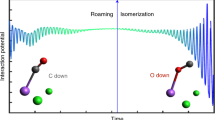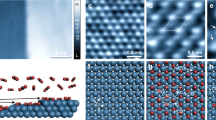Abstract
Understanding gas–surface reaction dynamics, such as the rupture and formation of bonds in vibrationally and translationally excited (‘hot’) molecules, is important to provide mechanistic insight into heterogeneous catalytic processes. Although it has been established that such excitation can affect the reactions occurring via dissociative mechanisms, for associative mechanisms—in which the gas-phase reactant collides directly with a surface-adsorbed species—only translational excitation has been observed to affect reactivity. Here we report a bond-formation reaction that is driven by the vibrational energy of reactant molecules and occurs via an (associative) Eley–Rideal-type mechanism, in which the reaction takes place in a single collision. Hot CO2 in a molecular beam is found to react with pre-adsorbed hydrogen atoms directly on cold Cu(111) and Cu(100) surfaces to form formate adspecies. The vibrational energy of CO2 is more effective at promoting the reaction than translational energy, the reaction rate is independent of the surface temperature and the experimental results are consistent with density functional theory calculations.
This is a preview of subscription content, access via your institution
Access options
Access Nature and 54 other Nature Portfolio journals
Get Nature+, our best-value online-access subscription
$29.99 / 30 days
cancel any time
Subscribe to this journal
Receive 12 print issues and online access
$259.00 per year
only $21.58 per issue
Buy this article
- Purchase on Springer Link
- Instant access to full article PDF
Prices may be subject to local taxes which are calculated during checkout





Similar content being viewed by others
Data availability
All results are reported in the main paper and Supplementary Information, and all data are available from the authors upon reasonable request.
References
Polanyi, J. C. Some concepts in reaction dynamics. Acc. Chem. Res. 5, 161–168 (1972).
Lee, Y. T. Molecular beam studies of elementary chemical processes. Science 236, 793–798 (1987).
Liu, K. Vibrational control of bimolecular reactions with methane by mode, bond and stereo selectivity. Annu. Rev. Phys. Chem. 67, 91–111 (2016).
Kleyn, A. W. Molecular beams and chemical dynamics at surfaces. Chem. Soc. Rev. 32, 87–95 (2003).
Gross, A. et al. in The Chemical Physics of Solid Surfaces Vol. 11 (ed. Woodruff, D. P.) 1–378 (Elsevier, 2003).
Michelsen, H. A., Rettner, C. T. & Auerbach, D. J. in Surface Reactions (ed. Madix, R. J.) 185–237 (Springer, 1994).
Hayden, B. E. in Dynamics of Gas–Surface Interactions (eds Rettner, C. T. & Ashfold, M. N. R.) 137–170 (The Royal Society of Chemistry, 1991).
Rettner, C. T. Dynamics of the direct reaction of hydrogen atoms adsorbed on Cu(111) with hydrogen atoms incident from the gas phase. Phys. Rev. Lett. 69, 383–386 (1992).
Juurlink, L. B. F., Killelea, D. R. & Utz, A. L. State-resolved probes of methane dissociation dynamics. Prog. Surf. Sci. 84, 69–134 (2009).
Díaz, C. et al. Chemically accurate simulation of a prototypical surface reaction: H2 dissociation on Cu(111). Science 326, 832–834 (2009).
Nattino, F. et al. Ab initio molecular dynamics calculations versus quantum-state-resolved experiments on CHD3 + Pt(111): new insights into a prototypical gas–surface reaction. J. Phys. Chem. Lett. 5, 1294–1299 (2014).
Eley, D. & Rideal, E. Parahydrogen conversion on tungsten. Nature 146, 401–402 (1940).
Weinberg, W. H. Eley−Rideal surface chemistry: direct reactivity of gas phase atomic hydrogen with adsorbed species. Acc. Chem. Res. 29, 479–487 (1996).
Ertl, G. in Handbook of Heterogeneous Catalysis Vol. 3 (eds Ertl, G., Knözinger, H. & Weitkamp, J.) 1462–1479 (Wiley-VCH, 2008).
Nakano, H., Nakamura, I., Fujitani, T. & Nakamura, J. Structure-dependent kinetics for synthesis and decomposition of formate species over Cu(111) and Cu(110) model catalysts. J. Phys. Chem. B 105, 1355–1365 (2001).
Nakamura, J., Kushida, Y., Choi, Y., Uchijima, T. & Fujitani, T. X-ray photoelectron spectroscopy and scanning tunnel microscope studies of formate species synthesized on Cu(111) surfaces. J. Vac. Sci. Technol. A 15, 1568–1571 (1997).
Taylor, P. A., Rasmussen, P. B., Ovesen, C. V., Stoltze, P. & Chorkendorff, I. Formate synthesis on Cu(100). Surf. Sci. 261, 191–206 (1992).
Wang, G., Morikawa, Y., Matsumoto, T. & Nakamura, J. Why is formate synthesis insensitive to copper surface structures? J. Phys. Chem. B 110, 9–11 (2006).
Muttaqien, F. et al. Desorption dynamics of CO2 from formate decomposition on Cu(111). Chem. Commun. 53, 9222–9225 (2017).
Sakaki, S. & Ohkubo, K. Characteristic features of carbon dioxide insertion into a copper–hydrogen bond. An ab initio MO study. Inorg. Chem. 27, 2020–2021 (1988).
Bagherzadeh, S. & Mankad, N. P. Catalyst control of selectivity in CO2 reduction using a tunable heterobimetallic effect. J. Am. Chem. Soc. 137, 10898–10901 (2015).
Quan, J., Kondo, T., Wang, G. & Nakamura, J. Energy transfer dynamics of formate decomposition on Cu(110). Angew. Chem. Int. Ed. 56, 3496–3500 (2017).
Anger, G., Winkler, A. & Rendulic, K. D. Adsorption and desorption kinetics in the systems H2/Cu(111), H2/Cu(110) and H2/Cu(100). Surf. Sci. 220, 1–17 (1989).
Fujitani, T., Nakamura, I., Ueno, S., Uchijima, T. & Nakamura, J. Methanol synthesis by hydrogenation of CO2 over a Zn-deposited Cu(111): formate intermediate. Appl. Surf. Sci. 121-122, 583–586 (1997).
Nishimura, H., Yatsu, T., Fujitani, T., Uchijima, T. & Nakamura, J. Synthesis and decomposition of formate on a Cu(111) surface–kinetic analysis. J. Mol. Catal. A 155, 3–11 (2000).
Lee, M. B., Yang, Q. Y. & Ceyer, S. T. Dynamics of the activated dissociative chemisorption of CH4 and implication for the pressure gap in catalysis: a molecular beam-high resolution electron energy loss study. J. Chem. Phys. 87, 2724–2741 (1987).
Luntz, A. C. A simple model for associative desorption and dissociative chemisorption. J. Chem. Phys. 113, 6901–6905 (2000).
Smith, R. R., Killelea, D. R., DelSesto, D. F. & Utz, A. L. Preference for vibrational over translational energy in a gas–surface reaction. Science 304, 992–995 (2004).
Hundt, P. M., Jiang, B., vanReijzen, M. E., Guo, H. & Beck, R. D. Vibrationally promoted dissociation of water on Ni(111). Science 344, 504–507 (2014).
Muttaqien, F. et al. CO2 adsorption on the copper surfaces: van der Waals density functional and TPD studies. J. Chem. Phys. 147, 094702 (2017).
Mondal, B., Song, J., Neese, F. & Ye, S. Bio-inspired mechanistic insights into CO2 reduction. Curr. Opin. Chem. Biol. 25, 103–109 (2015).
Jackson, B. & Persson, M. A quantum mechanical study of recombinative desorption of atomic hydrogen on a metal surface. J. Chem. Phys. 96, 2378–2386 (1992).
Jackson, B. & Lemoine, D. Eley–Rideal reactions between H atoms on metal and graphite surfaces: the variation of reactivity with substrate. J. Chem. Phys. 114, 474–482 (2001).
Casolo, S., Tantardini, G. F. & Martinazzo, R. Hydrogen recombination and dimer formation on graphite from ab initio molecular dynamics simulations. J. Phys. Chem. A 120, 5032–5040 (2016).
Campbell, J. M. & Campbell, C. T. The dissociative adsorption of H2 and D2 on Cu(110): activation barriers and dynamics. Surf. Sci. 259, 1–17 (1991).
Chorkendorff, I., Alstrup, I. & Ullmann, S. XPS study of chemisorption of CH4 on Ni(100). Surf. Sci. 227, 291–296 (1990).
Jackson, B., Persson, M. & Kay, B. D. Quantum mechanical study of H(g) + Cl–Au(111): Eley–Rideal mechanism. J. Chem. Phys. 100, 7687–7695 (1994).
Rettner, C. T. & Auerbach, D. J. Dynamics of the Eley–Rideal reaction of D atoms with H atoms adsorbed on Cu(111): vibrational and rotational state distributions of the HD product. Phys. Rev. Lett. 74, 4551–4554 (1995).
Zaharia, T., Kleyn, A. W. & Gleeson, M. A. Eley–Rideal reactions with N atoms at Ru(0001): formation of NO and N2. Phys. Rev. Lett. 113, 053201 (2014).
Kuipers, E. W., Vardi, A., Danon, A. & Amirav, A. Surface-molecule proton transfer: a demonstration of the Eley–Rideal mechanism. Phys. Rev. Lett. 66, 116–119 (1991).
Nakamura, J., Choi, Y. & Fujitani, T. On the issue of the active site and the role of ZnO in Cu/ZnO methanol synthesis catalysts. Top. Catal. 22, 277–285 (2003).
Kondo, T., Kato, H. S., Yamada, T., Yamamoto, S. & Kawai, M. Effect of the molecular structure on the gas–surface scattering studied by supersonic molecular beam. Eur. Phys. J. D 38, 129–138 (2006).
Kondo, T., Kato, H. S., Bonn, M. & Kawai, M. Deposition and crystallization studies of thin amorphous solid water films on Ru(0001) and on CO-precovered Ru(0001). J. Chem. Phys. 127, 094703 (2007).
Morikawa, Y., Iwata, K., Nakamura, J., Fujitani, T. & Terakura, K. Ab initio study of surface structural changes during methanol synthesis over Zn/Cu(111). Chem. Phys. Lett. 304, 91–97 (1999).
Morikawa, Y., Iwata, K. & Terakura, K. Theoretical study of hydrogenation process of formate on clean and Zn deposited Cu(111) surfaces. Appl. Surf. Sci. 169-170, 11–15 (2001).
Muttaqien, F., Hamamoto, Y., Inagaki, K. & Morikawa, Y. Dissociative adsorption of CO2 on flat, stepped and kinked Cu surfaces. J. Chem. Phys. 141, 034702 (2014).
Klimeš, J., Bowler, D. R. & Michaelides, A. Van der Waals density functionals applied to solids. Phys. Rev. B 83, 195131 (2011).
Thonhauser, T. et al. Van der Waals density functional: self-consistent potential and the nature of the van der Waals bond. Phys. Rev. B 76, 125112 (2007).
Román-Pérez, G. & Soler, J. M. Efficient implementation of a van der Waals density functional: application to double-wall carbon nanotubes. Phys. Rev. Lett. 103, 096102 (2009).
Wu, J. & Gygi, F. A simplified implementation of van der Waals density functionals for first-principles molecular dynamics applications. J. Chem. Phys. 136, 224107 (2012).
Hamamoto, Y., Hamada, I., Inagaki, K. & Morikawa, Y. Self-consistent van der Waals density functional study of benzene adsorption on Si(100). Phys. Rev. B 93, 245440 (2016).
Vanderbilt, D. Soft self-consistent pseudopotentials in a generalized eigenvalue formalism. Phys. Rev. B 41, 7892 (1990).
Lide, D. R. CRC Handbook of Chemistry Physics Vol. 79 (CRC Press, Boca Raton, 1998).
Mills, G., Jónsson, H. & Schenter, G. K. Reversible work transition state theory: application to dissociative adsorption of hydrogen. Surf. Sci. 324, 305–337 (1995).
Henkelman, G., Uberuaga, B. P. & Jónsson, H. A climbing image nudged elastic band method for finding saddle points and minimum energy paths. J. Chem. Phys. 113, 9901–9904 (2000).
Wilson, E. B., Decius, J. C. & Cross, P. C. Molecular Vibrations (Dover Publications, 1955).
Acknowledgements
Financial support was provided by the Advanced Catalytic Transformation Program for Carbon Utilization (ACT-C) of the Japan Science and Technology Agency (JST). The numerical calculations were performed with computer resources at the Institute for Solid State Physics (ISSP), University of Tokyo, with HPCI systems provided by Nagoya University, the University of Tokyo and Tohoku University through the HPCI System Research Project (project nos. hp130112, hp140166 and hp150201). Theoretical calculations were partly supported by Grants-in-Aid for Scientific Research on Innovative Areas 3D Active-Site Science (nos. 26105010 and 26105011) from the Japan Society for the Promotion of Science (JSPS), and the Elements Strategy Initiative for Catalysts and Batteries (ESICB) supported by the Ministry of Education, Culture, Sports, Science and Technology, Japan (MEXT). J.Q. thanks Y. Horiike and M. Kitajima for fruitful discussions.
Author information
Authors and Affiliations
Contributions
J.N. and Y.M. conceived and designed the project. J.Q., T.Kon, T.Koz., T.M. and T.I. performed experiments. J.Q., T.Kon., T.Koz., T.M., T.I. and J.N. analysed experimental results. F.M. performed calculations and data analysis, with contributions from Y.H., K.I. and I.H. J.N. supervised experiments. Y.M. supervised calculations. J.Q., F.M., T.Kon., I.H., Y.M. and J.N. wrote the manuscript. All authors contributed to the scientific discussion and helped in writing the manuscript.
Corresponding author
Ethics declarations
Competing interests
The authors declare no competing interests.
Additional information
Publisher’s note: Springer Nature remains neutral with regard to jurisdictional claims in published maps and institutional affiliations.
Supplementary Information
Supplementary Information
Supplementary methods, Supplementary Figs. 1–25, Supplementary Tables 1–4
Rights and permissions
About this article
Cite this article
Quan, J., Muttaqien, F., Kondo, T. et al. Vibration-driven reaction of CO2 on Cu surfaces via Eley–Rideal-type mechanism. Nat. Chem. 11, 722–729 (2019). https://doi.org/10.1038/s41557-019-0282-1
Received:
Accepted:
Published:
Issue Date:
DOI: https://doi.org/10.1038/s41557-019-0282-1
This article is cited by
-
Comparative investigation of structural, photoluminescence, and magnetic characteristics of MxSn1−xOy nanocomposites
Applied Physics A (2023)
-
Hydrogenomics: Efficient and Selective Hydrogenation of Stable Molecules Utilizing Three Aspects of Hydrogen
Catalysis Letters (2022)
-
Engineering the Cu/Mo2CTx (MXene) interface to drive CO2 hydrogenation to methanol
Nature Catalysis (2021)



